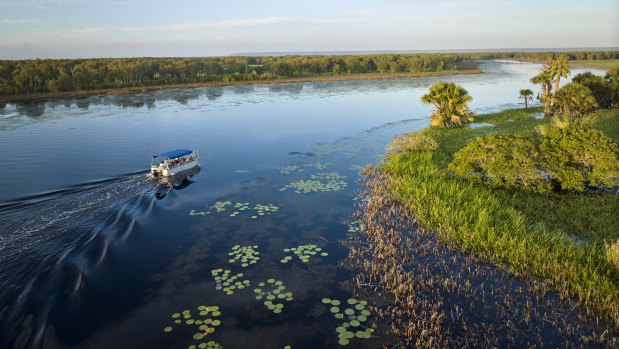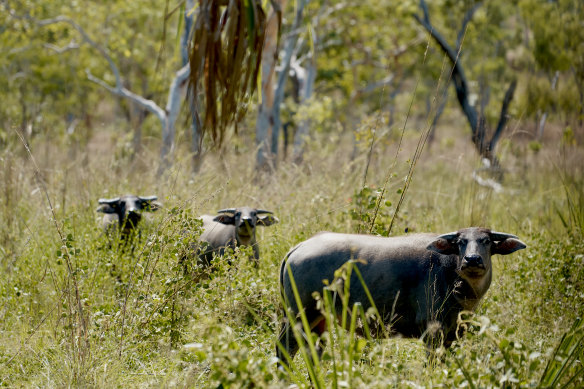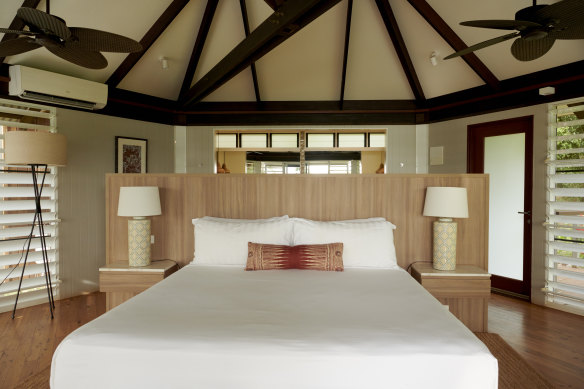This was published 1 year ago
This outback safari may be Australia’s greatest wildlife spectacular
By Mark Daffey
I’ve just completed an afternoon drive with Murwangi Safari Camp’s traditional owners and am feeling refreshed following a hot shower. With an hour to spare before our three-course dinner is served in the camp dining room, I sink into a lounge chair on the decking of my swish, tented accommodation, thinking I’ll use the time to flick through the hundreds of photographs that I must have taken during the day.

On safari in Arnhem Land.
I pour myself a cold drink then stretch my legs out on the coffee table in front of me. By this point, I’m already distracted from the task at hand by a gaggle of magpie geese taking flight across the Glyde River lagoon, honking like bicycle horns as they erupt from the water’s edge. Then I hear little corellas chattering and screeching away as they nestle among the branches of paperbark trees. A trio of wild brumbies with dusty coats snort as they graze on stubbled grasses nearby.
In the distance, the sound of a diesel motor bursting to life disturbs nature’s chorus. Shortly after, camp manager Keith Hamelink tears past my door in an all-terrain vehicle, steering a diagonal line towards a line of mangrove trees. He reappears several minutes later, halting beneath the steps to my accommodation.
“Want to see something cool?” he asks.
“What is it?” I reply.
“You’ll have to come with me to find out.”
“Should I bring this?” I ask, holding up a camera.
He shrugs. “Up to you.”
Afraid that I might miss out on adding to my already-bulging photographic collection, I throw my camera bag over my shoulder then jump in beside Hamelink as he guides the ATV through the mangrove bushes. On the other side of those trees is a sight that’s totally unexpected, given how well hidden it was from my outdoor setting just a hundred metres away. Spread out before us, wallowing in marshy wetlands and basking in the sun’s final rays, is a muscular herd of about 30 buffalo.

Where the buffalo roam.
“Now, that is impressive,” I say, turning towards Hamelink.
“Not bad, hey?”
Earlier that day, I’m smitten by the variety and quantity of wildlife I see during a morning cruise across the Glyde River lagoon – part of the largest freshwater swamp in Arnhem Land. Waterbirds are the main attraction, and there are thousands of them – herons, egrets, fish eagles and comb-crested jacanas that are otherwise known as “Jesus birds” for appearing as though they can walk on water. A saltwater crocodile lazes beneath the limp fronds of a pandanus palm down a side inlet. A second croc dashes out from its hiding place among waist-high reeds to swim across the lagoon in front of us. Buffalos wade through shallows deep enough to tickle their undersides.
The buffalos we saw then were mostly solitary, and almost always blended into the tropical foliage surrounding the lagoon. But never did we see this many in one place or from this proximity.
“Want to see what happens if we get a little closer?” says Hamelink.
How can I say no?
He presses down hard on the accelerator. The buffalos react immediately, setting off on a galloping stampede through the sodden marshes. Upon reaching the drier soils near the mangrove trees, they turn towards us with nostrils raised and ears pricked, assessing the threat of danger. But rather than leaving them in peace, Hamelink revs the motor again. Goodbye buffalos.
“Let’s see what else we can find,” he says, with mischievous intent.
It isn’t long before we stumble across some of the 80-odd wild brumbies that roam freely on the property. We also find a mob of feral pigs, each with their snouts buried deep in the muddy soils between the paperbarks. A dingo pack slinks through the shadows near a dump of rusting farm vehicles. A lone jabiru, or black-necked stork, delicately placing its feet with each step forward, gazes intently towards the shallow lagoon water and the piscine nourishment it contains.
“Do you ever tire of doing this?” I ask Hamelink, soon after we claim victory over a tempestuous buffalo bull following a Mexican stand-off on a vehicle track.
“Never,” he says, shaking his head. “It’s my favourite part of the day.”
I’m totally envious. I’m also thankful to Hamelink for taking me on his faunagraphic joyride around the property, for of all the things I anticipated seeing and doing on this 13-day overland tour through Arnhem Land, it’s the wildlife safaris that I looked forward to most. More than the Indigenous rock art depicting rainbow serpents, thylacines or European tall ships. More, too, than the visits to art galleries and museums in remote Aboriginal communities. More than the near-certainty of hooking a barramundi on the Liverpool River catchment area. More, also, than an historic walking tour through a failed, 19th-century colonial settlement in Port Essington. And more, even, than the promise of a six-course degustation menu for dinner on my final night at the Outback Spirit-owned Seven Spirit Bay resort.

Camping in style.
Even before Hamelink offered me front-row seats, I was beginning to wonder whether Murwangi boasted the greatest wildlife spectacular in Australia. Try as I might, I couldn’t think of anywhere else that topped it. Kakadu’s Yellow Waters? Maybe, but not quite. Kangaroo Island? Not nearly in such quantities. The little-known Narawntapu National Park in Northern Tasmania? For native marsupials, yes, but otherwise no. The best I could come up with were all underwater – Ningaloo, the Great Barrier Reef, Lord Howe Island – around coral reefs. Nothing on land beat it.
A Top End Species Checklist produced by Outback Spirit details 21 mammals, 44 reptiles, eight amphibians and a staggering 291 bird varieties found at Murwangi and at any of the other three camps we stay at during our tour across Arnhem Land. Native mammals include short-beaked echidnas, northern brown bandicoots and sugar gliders. Introduced species include Timorese ponies, Indonesian bantengs and the 250,000-odd Asiatic water buffaloes populating these wetlands, all of them imported from South-East Asia as beasts of burden by early colonialists and pastoralists.
Reptiles like frill-necked lizards can be seen scurrying up tree trunks. Merten’s water monitors rarely stray far from Arnhem Land’s natural waterholes. Green and brown tree snakes – “the most harmless snakes that ever were”, according to Hamelink – occasionally find their way into guest bathrooms, requiring staff members to rescue and relocate them. As you’d expect of wild animals, they don’t always behave.
“We once had a buffalo chase a guest around a tree after he decided to try and get up close for a photo,” says Hamelink. “And a crocodile made it as far as our airstrip at the start of the year. We weren’t sure if he was lost or going on holiday.”
Guests haven’t always been privy to the bounteous wildlife viewing opportunities found at Murwangi. For years, the property operated as a cattle station, complete with its own abattoir and market garden. After Outback Spirit leased the property from its Yolngu owners in 2016, they erected 12 Deluxe Safari Suites, each of them facing the Glyde River lagoon.
“It really is a privilege to be able to live here on Yolngu land because it’s not an easy place to get to, or to get access to. And the thing is, they want us to be here,” says Hamelink’s partner, Taylah.
The camp’s location, 560 kilometres east of Darwin and 420 kilometres west of Nhulunbuy, is remote. But it’s also exclusive to Outback Spirit guests during the five-month tourist season, from May to September. For the remainder of the year it’s closed, so annual visitor numbers are tightly controlled.
That exclusivity, for me, is one of its headline attractions. Unlike safaris in East Africa, say, or even Kakadu, here millions of birds, mammals, reptiles and amphibians can be seen by a maximum of 24 people – plus guides – at any one time. It’s wild even thinking about that.
THE DETAILS
Tour
Outback Spirit’s 13-day Arnhem Land Wilderness Adventure tours depart every two or three days during the Top End dry season, from May to September. Includes flights from Cairns to Nhulunbuy and from Seven Spirit Bay to Darwin, as well as all accommodation, permits, attraction fees, meals and beverages. From $11,495 a person, twin-share. See outbackspirittours.com.au
The writer was a guest of Outback Spirit.
Sign up for the Traveller Deals newsletter
Get exclusive travel deals delivered straight to your inbox. Sign up now.